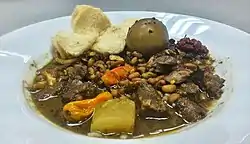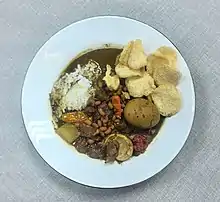 A plate of brongkos, a spicy Javanese meat and bean stew. | |
| Course | Main course |
|---|---|
| Place of origin | Indonesia |
| Region or state | Yogyakarta, Central Java |
| Serving temperature | Hot or room temperature |
| Main ingredients | Black-eyed pea, meat (beef, goat meat or mutton), palm sugar, chili, kluwek, various spices, coconut milk, egg |
Brongkos is a Javanese spicy meat and beans stew, specialty of Yogyakarta and other cities in Central Java, Indonesia.[1]
Brongkos stew should not be confused with the similarly named brengkes—the Javanese name for pepes which is food cooked in banana leaf package.
Ingredients
Brongkos consists of diced meat; either beef, goat meat or mutton, hard boiled egg and tofu, stewed with beans, usually black-eyed peas or red kidney beans and diced chayote and sometimes carrots.
The coconut milk-based stews uses a rich mixture of spices, which includes black kluwek, bruised lemongrass, kaffir lime leaves, bay leaves, salt, palm sugar, spice paste consists of ground galangal, kencur, ginger, coriander, shallot and roasted candlenut, also a whole of bird's eye chilies which add a surprising hot spiciness when bitten.[2]
Brongkos often served together with steamed rice in a single plate as nasi brongkos (lit. "brongkos rice").
History and popularity

Brongkos, together with gudeg, sayur lodeh and rawon are considered as a classic Javanese dish. It is known as one of the royal dishes of the Kraton Yogyakarta, since it was said as the favourite dish of late Sultan Hamengkubuwono IX and his successor Sultan Hamengkubuwono X,[3] thus subsequently offered in Bale Raos royal Javanese restaurant located within Yogyakarta palace compound and often served to the visiting royal guests.[4]
Although brongkos is often associated with the city of Yogyakarta,[5] this spicy meat and beans stew is quite widespread in Javanese tradition, especially in Central Java, as some cities has their own version and specialty, such as Demak, Solo,[6] Magelang,[7] and Temanggung.[8]
Etymology
The word “Brongkos” originally is from French, meaning “brownhorst,” which later became “Brongkos” in Java dialect meaning brown-meat food.[9]
See also
Notes
- ↑ "Sebelum Keliling Kota Yogyakarta, Ini 6 Kuliner Khas Jogja yang Sering Dijadikan Menu Sarapan". Tribunnews.com (in Indonesian). Retrieved 2020-06-11.
- ↑ Devi Setya Lestari (10 November 2017). "Brongkos, Kuliner Indonesia dari Jawa Tengah yang Nikmat Berbumbu Kluwek, Coba Juga Resepnya!". Okezone.com. Retrieved 12 June 2020.
- ↑ "Ini Bukti Kalau Brongkos Jadi Kuliner Favorit Sri Sultan Hamengkubuwono X". suara.com (in Indonesian). 2019-12-18. Retrieved 2020-06-12.
- ↑ Wicaksono, Pribadi (2020-03-11). "Ini Menu yang Dihidangkan Kepada Raja Belanda di Keraton Yogya". Tempo. Retrieved 2020-06-12.
- ↑ Times, I. D. N.; Fatiya. "7 Warung Brongkos Paling Terkenal di Yogyakarta, Rasanya Nikmat!". IDN Times (in Indonesian). Retrieved 2020-06-11.
- ↑ "Masja Warung Brongkos Yang Melegenda di Solo". sisiusaha. Archived from the original on 2020-06-11. Retrieved 2020-06-11.
- ↑ Media, Kompas Cyber. "Warung Ini Ramai Pembeli, Menu Andalannya Brongkos Sapi". KOMPAS.com (in Indonesian). Retrieved 2020-06-11.
- ↑ Media, Kompas Cyber. "Empis-empis dan Brongkos Temanggung yang Bikin Kangen". KOMPAS.com (in Indonesian). Retrieved 2020-06-11.
- ↑ Harmayani, Eni; Anal, Anil Kumar; Wichienchot, Santad; Bhat, Rajeev; Gardjito, Murdijati; Santoso, Umar; Siripongvutikorn, Sunisa; Puripaatanavong, Jindaporn; Payyappallimana, Unnikrishnan (2019-07-17). "Healthy food traditions of Asia: exploratory case studies from Indonesia, Thailand, Malaysia, and Nepal". Journal of Ethnic Foods. 6 (1): 1. doi:10.1186/s42779-019-0002-x. ISSN 2352-6181.